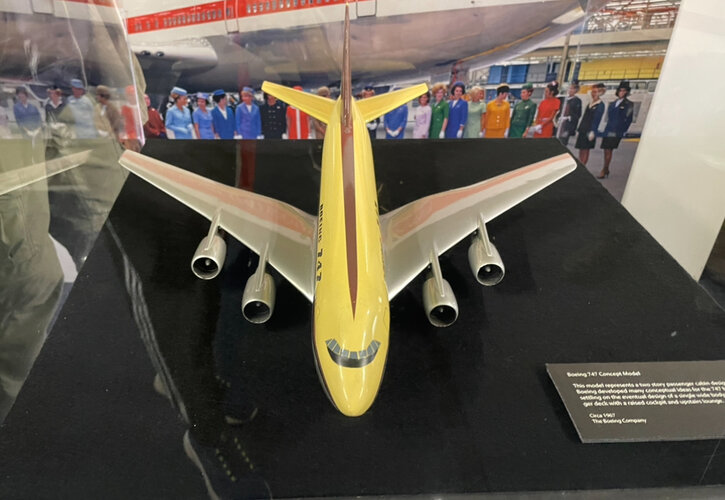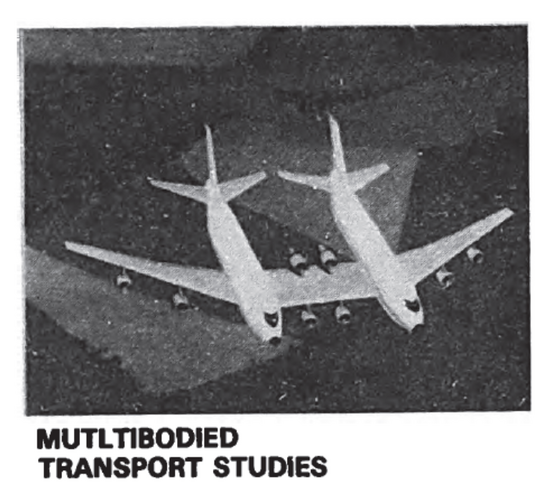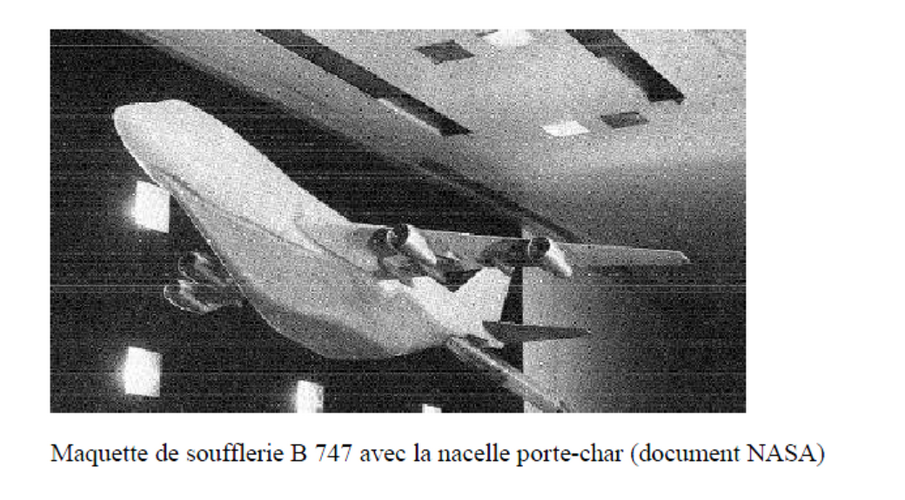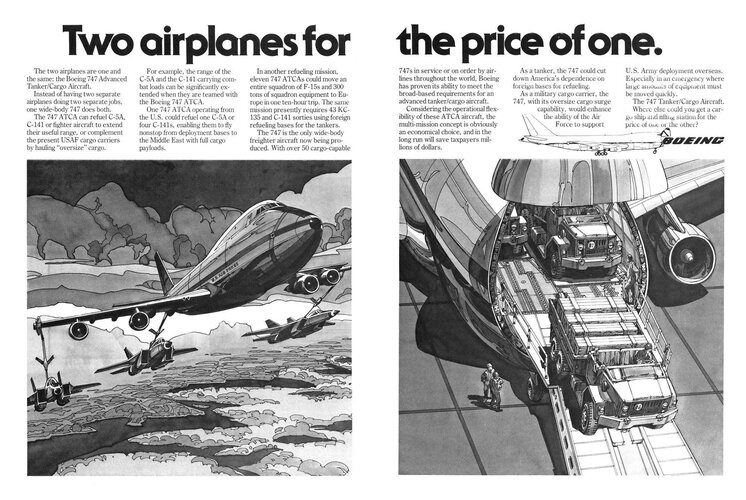In an act of remarkble stupidity, I decided to take a front view of all things of this exact model.From, Boeing 747 A History,
please look to picture 4 ,what was this ?,maybe I can't
see well !.
You are using an out of date browser. It may not display this or other websites correctly.
You should upgrade or use an alternative browser.
You should upgrade or use an alternative browser.
Unbuilt, experimental and unusual Boeing 747s
- Thread starter Dronte
- Start date
carsinamerica
ACCESS: Confidential
- Joined
- 18 February 2010
- Messages
- 118
- Reaction score
- 59
Not stupid at all. That photo captures something important. It shows just how narrowly the turbofans were placed on the early 747s. One of the last major design changes, if memory serves, was moving the engines further out on the wing and spacing them further apart.In an act of remarkble stupidity, I decided to take a front view of all things of this exact model.
- Joined
- 26 May 2006
- Messages
- 34,860
- Reaction score
- 15,723
So weird, does anyone show this concept before (B-747 with tank carrier pod) ?,
I can't understand this concept !
I can't understand this concept !
Attachments
Last edited:
- Joined
- 1 April 2006
- Messages
- 11,372
- Reaction score
- 10,188
Scott Kenny
ACCESS: USAP
- Joined
- 15 May 2023
- Messages
- 11,513
- Reaction score
- 14,082
I'd actually expect the single engine to be on the outboard pylon. You'd need less rudder trim designed in that way.Dear Sentinel Chicken,
is there in the book a picture to say if my interpretation below is right or wrong?
Wait - Iran had 747 tankers ? do we have a thread about that somewhere ?
View: https://www.youtube.com/watch?v=oCv-uy9cAG0
AFAIK, they still have one of them in service.Wait - Iran had 747 tankers ? do we have a thread about that somewhere ?
Scott Kenny
ACCESS: USAP
- Joined
- 15 May 2023
- Messages
- 11,513
- Reaction score
- 14,082
Heaven forbid someone say the quiet part out loud...Wingtip-mounted flying booms never seem to make it to the hardware stage and I can imagine some complications that might make them impractical. Similar placement of hose-and-drogue units has some precedent, but not in the USAF (for fixed wing aircraft anyway) although it's been proposed and even programmed several times. A cynic might point out that a multi-point hose-and-drogue refueling capability would make USAF-supported USN/USMC/NATO operations more competitive with all-USAF operations (simultaneous low-flowrate hose-and-drogue connections versus a single high-flowrate flying boom connection), but that would suggest that the USAF is institutionally unenthusiastic about it's assigned missions in support other services.
Here's a clean Boeing 747 model (1/20 scale -- about 12-ft. long) with or without winglets. Made by Pacific Miniatures, it comes with its original carrying crate, visible in the background.
This is what collectors refer to as a "divorce model" because of what happens when you try to put it in the living room, where it belongs.
Think it's already been answered, but there aren't any 500pax turboprops, and not all of the major cities were linked via Shinkansen high speed trains at the time. I'm not sure some cities are linked yet, due to the distances between some of the islands.[fixed gear 747 weirdness]
The question is then, why would you use a jet for something a turboprop would do much better?
Remember, Japan has 130mil people, all shoved into a total land area about equal to that of California. Or rather, 1/10 the area of California, because everything else is too steep to put houses on...
T. A. Gardner
ACCESS: Top Secret
- Joined
- 18 February 2021
- Messages
- 1,145
- Reaction score
- 2,004
This variant was actually built and flown.Artist's impression of Boeing 747 LCF (Large Cargo Freighter).
Wind-tunnel model of Boeing 747 LCF.
Via Internet Archive:
http://web.archive.org/web/20050206040440/www.boeing.com/commercial/7e7/photos.html
Close Call With B747LCF Vortices Nearly Claims C172 | Aero-News Network
Instructor Recovers After Aircraft Rolls 90 Degrees and Pitches Nose-Down Vertical And you thought YOU had some close calls? If you want a lit| Published: Fri, Nov 24, 2006 | Aero-News Network
www.aero-news.net

After getting paint


Scott Kenny
ACCESS: USAP
- Joined
- 15 May 2023
- Messages
- 11,513
- Reaction score
- 14,082
Wonder how long it took the instructor to remove the seat cushion from her backside? That's some pucker factor well over 9000!Close Call With B747LCF Vortices Nearly Claims C172 | Aero-News Network
Instructor Recovers After Aircraft Rolls 90 Degrees and Pitches Nose-Down Vertical And you thought YOU had some close calls? If you want a lit| Published: Fri, Nov 24, 2006 | Aero-News Networkwww.aero-news.net
isayyo2
Lurker alert
- Joined
- 24 November 2011
- Messages
- 1,131
- Reaction score
- 2,323
Check it out!Wait - Iran had 747 tankers ? do we have a thread about that somewhere ?
View: https://www.youtube.com/watch?v=oCv-uy9cAG0
I thought I saw that in GUNDAM WING.So weird, does anyone show this concept before (B-747 with tank carrier pod) ?,
I can't understand this concept !
isayyo2
Lurker alert
- Joined
- 24 November 2011
- Messages
- 1,131
- Reaction score
- 2,323
2 for 1
The Boeing 747 Advanced Tanker Cargo Aircraft

 theairchive.net
theairchive.net


The Boeing 747 Advanced Tanker Cargo Aircraft

Boeing 2 for 1 The Boeing 747 Advanced Tanker Cargo Aircraft Brochure May 1977 from La Jetée Press
Boeing 2 for 1 The Boeing 747 Advanced Tanker Cargo Aircraft Brochure May 1977 from La Jetée Press
 theairchive.net
theairchive.net
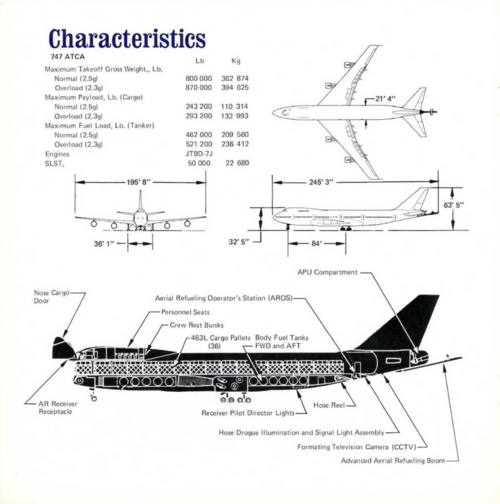
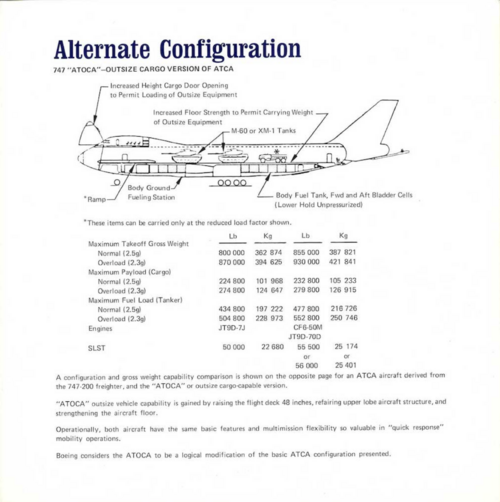
- Joined
- 5 May 2007
- Messages
- 1,481
- Reaction score
- 2,853
The payload-range graph comparing the C-5 to the 747 ATCA is interesting, because the curve of the 'maximum-weight' section of the graph is the same for the 747 and C-5, with a constant offset. The implication is either that the C-5 has near-identical fuel consumption characteristics to a 747, or that Boeing modelled the C-5 by assuming it was a 747 with a lower MTOW and smaller fuel tanks.
Scott Kenny
ACCESS: USAP
- Joined
- 15 May 2023
- Messages
- 11,513
- Reaction score
- 14,082
Same engines (or close to it) and similar aerodynamics. So I'm sure the TSFC is within a % or two.The payload-range graph comparing the C-5 to the 747 ATCA is interesting, because the curve of the 'maximum-weight' section of the graph is the same for the 747 and C-5, with a constant offset. The implication is either that the C-5 has near-identical fuel consumption characteristics to a 747, or that Boeing modelled the C-5 by assuming it was a 747 with a lower MTOW and smaller fuel tanks.
Christopher Wang
ACCESS: Secret
- Joined
- 3 June 2021
- Messages
- 274
- Reaction score
- 581
Google Translate: "Boeing project for a liquid hydrogen 747. For a range greater than that of the B-747-200B, this aircraft would only consume 41 tonnes of fuel, compared to 121 tonnes, resulting in a take-off weight of 267 t instead of 351 t."From Aviation magazine 1980.
Scott Kenny
ACCESS: USAP
- Joined
- 15 May 2023
- Messages
- 11,513
- Reaction score
- 14,082
At a cost of 574,000 liters of fuel tank capacity.Google Translate: "Boeing project for a liquid hydrogen 747. For a range greater than that of the B-747-200B, this aircraft would only consume 41 tonnes of fuel, compared to 121 tonnes, resulting in a take-off weight of 267 t instead of 351 t."
T. A. Gardner
ACCESS: Top Secret
- Joined
- 18 February 2021
- Messages
- 1,145
- Reaction score
- 2,004
But, would you really want to travel in what amounts to a jet powered "Hindenburg?"At a cost of 574,000 liters of fuel tank capacity.
Scott Kenny
ACCESS: USAP
- Joined
- 15 May 2023
- Messages
- 11,513
- Reaction score
- 14,082
I'd rather fly in the Hindenburg proper than a 747 with that much volume in fuel tankage. It'd probably be cheaper!But, would you really want to travel in what amounts to a jet powered "Hindenburg?"
Similar threads
-
Boeing 747 Advanced Surveillance & Tracking Technology (ASTT)
- Started by Dronte
- Replies: 11
-
-
Unbuilt ASW/MARPAT versions of airliners?
- Started by Sentinel Chicken
- Replies: 146
-
-

